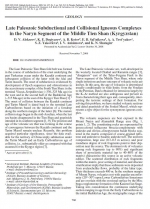Добрый день, Коллеги. Важное сообщение, просьба принять участие. Музей Ферсмана ищет помощь для реставрационных работ в помещении. Подробности по ссылке
Late Paleozoic Subductional and Collisional Igneous Complexes in the Naryn Segment of the Middle Tien Shan (Kyrgyzstan)
The Late Paleozoic Tien Shan fold belt was formed in the course of subduction of the crust underlying the past Turkestan ocean under the Kazakh continent and subsequent collision of the latter with the Alai and Tarim massifs. The onset of subduction is evidenced by development of flysch sequences and olistostromes in the accretionary complex of the South Tien Shan: in the terminal Visean–Serpukhovian (~330–325 Ma ago) in the west and in the second half of the Bashkirian Age (~315 Ma ago) in the east of the Kyrgyz Tien Shan [1].1 The onset of collision between the Kazakh continent and Tarim Massif is dated back to the terminal Late Carboniferous based on the initiation of a foredeep along the northern margin of the latter [6]. The mature collision stage began in the mid-Asselian, when the last sea basins disappeared in the Tien Shan and granitoids intruded in its southern segment [1, 9]. The position and age of the volcanic arc that was forming in the course of convergence between the Kazakh continent and the Tarim Massif remain unclear. Recently, this problem acquired particular significance, since the data available for the territory of China imply subduction under the Tarim Massif and an Early Carboniferous age of collision, i.e., substantially older as compared with that assumed for the Kyrgyz region [7].
The Late Paleozoic volcanic arc, well-developed in the westerly located Chatkal and Kuramin ranges [3], “disappears” east of the Talas–Fergana Fault in the Naryn segment of the Middle Tien Shan, where only single intrusions and rare outcrops of volcanic rocks are known. In this area, the age of volcanics is determined usually conditionally in wide limits: from the Vendian to the Permian. Dates obtained for intrusions largely by the K–Ar method are also ambiguous and prevent us from characterizing their ages and, consequently, interpreting the tectonic settings of their formation. For solving this problem, we have studied volcanic sections and dated granitoids of the Sonkul Massif, which represents a type object for the synonymous igneous complex.
The volcanic sequences are best exposed in the Mount Naryn and Alamashik Range area (Fig. 1, points 1, 2). The constituting rocks are represented by green-colored tuffaceous breccia-conglomerate with andesite and olivine–clinopyroxene basalt blocks scattered in the matrix composed of coarse-grained tuffs-tone and andesite to basaltic andesite tuff. The uniform composition, large size (0.3–0.5 m across), and poor roundness degree of rock fragments point to their deposition near the source. The dominant role of volcanics among rock fragments (up to 90%) and significant share of pyroclastic material (up to 40–80% of the matrix) characterize this source as an active volcanic edifice. The scattered distribution of rock fragments within the matrix, poor sorting of material, and obscure stratification imply that these sediments were deposited from avalanchelike flows, probably of the lahar type. Their thickness exceeds 400 m. In the southern margin of Mount Naryn, volcanics rest with angular unconformity (20°–30°) upon Lower Carboniferous limestones and are overlain with the erosional surface by the Min-buga conglomerate formation of the Kasimovian Stage. <...>




